By Roy Stevenson
ITWPA Member
Photographs by Linda Popovich
 Locked between mountains and the Gastineau Channel, Juneau is a great portal for visitors to be introduced to the rugged and beautiful “last frontier” state of Alaska. With a population of 31,000, Juneau is a cross between a city, a frontier town, a cruise ship destination, and small town America, all of which you will experience within minutes of each other.
Locked between mountains and the Gastineau Channel, Juneau is a great portal for visitors to be introduced to the rugged and beautiful “last frontier” state of Alaska. With a population of 31,000, Juneau is a cross between a city, a frontier town, a cruise ship destination, and small town America, all of which you will experience within minutes of each other.
Juneau’s cornucopia of natural splendor is really its stock-in-trade. You’re never far from an awe-inspiring glacier, rivers teeming with thousands of spawning salmon, or mammoth humpback whales breaching violently from the ocean. You can paddle across peaceful lakes, or ride a tramway up a steep mountain for a spectacular view of lush rain forest and shimmering fjords.
Juneau’s man-made attractions also pack some serious weight for their punch: sampling delectable amber ales at a renowned brewery, panning for gold on a river which hard-bitten prospectors worked over a century earlier, exploring a historic gold mine, and wandering through some interesting museums are all part of the Juneau experience. And watching the locals who emerge after the tidal wave of cruise passengers has receded back into its luxury liners is always instructive.
You can’t miss Juneau residents — they’re likely to be wearing the official footwear of Alaska, brown Neoprene XTRATUF Gumboots, with a half-inch-wide, cream-colored rim around the top and cream-colored soles. I once saw a flock of hot young women, dressed to kill in their miniskirts, participating in a Karaoke bar wearing these gumboots without the slightest hint of self-consciousness.
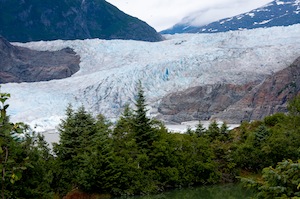 The Mendenhall Glacier is an ideal place to set the naturalistic stage for your visit to Juneau. Caught in a deep valley between tall granite outcrops, the glacier presents a breathtaking sight, with its bluish-gray cliffs and tall ridges of ice snaking down from a huge ice field. Sunk into the top of a small butte and surrounded by Northwest evergreens, the Mendenhall Glacier Visitor Center is an ideal place to view the glacier. Only a 15-minute drive from town, it’s the oldest visitor center in the U.S. Forest Service, and one mile from the huge glacier that dominates the vista.
The Mendenhall Glacier is an ideal place to set the naturalistic stage for your visit to Juneau. Caught in a deep valley between tall granite outcrops, the glacier presents a breathtaking sight, with its bluish-gray cliffs and tall ridges of ice snaking down from a huge ice field. Sunk into the top of a small butte and surrounded by Northwest evergreens, the Mendenhall Glacier Visitor Center is an ideal place to view the glacier. Only a 15-minute drive from town, it’s the oldest visitor center in the U.S. Forest Service, and one mile from the huge glacier that dominates the vista.
Inside the center’s auditorium, an 11-minute film tells how these phenomenal ice monsters are formed and recede in tandem with the pulse of nature, while other displays describe Alaska’s abundant wildlife. Outside, a short walk along a sealed trail gets you to Photo Point, where tourists snap away, recording this picture-perfect vista of lake, glacier, and mountains.
Descending a concrete walkway near the center, you arrive at a raised boardwalk set ten feet above the ground on metal stilts, where you can look down on the spawning salmon in the small glacial creek. It’s August and they’re writhing and wriggling as they fight their way up the rushing water, stopping for breathers in small side eddies. Recent evidence of bears is everywhere: chewed-up salmon carcasses, large crushed piles of grass, and black piles of scat. The bears are hungry, stocking up for their impending hibernation.
Nearby I read a sign that tells parents to keep their dogs on a leash and their children close — sound advice indeed. The bears are taking the afternoon off when we visit, but I’m told that when one lumbers onto the boardwalk, a ranger walks in front, warning visitors to move back and stand still while the bear passes. Wow, a personal ranger escort — welcome to Alaska!
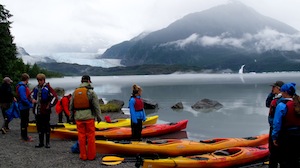 The next day we launch a kayak from Above & Beyond Alaska Company’s Kayak Center into the eerily quiet Mendenhall Lake. The calm waters are shrouded in lacy curtains of mist as we slowly paddle our way toward the glacier, about two miles distant. We silently glide among oddly-sculpted icebergs, some the size of small cars or large houses, as they loom up around us. Their colors change from blue to green to white depending on their depth and size. It’s like being in a giant ice-filled margarita glass, with a rim of forest and mountains.
The next day we launch a kayak from Above & Beyond Alaska Company’s Kayak Center into the eerily quiet Mendenhall Lake. The calm waters are shrouded in lacy curtains of mist as we slowly paddle our way toward the glacier, about two miles distant. We silently glide among oddly-sculpted icebergs, some the size of small cars or large houses, as they loom up around us. Their colors change from blue to green to white depending on their depth and size. It’s like being in a giant ice-filled margarita glass, with a rim of forest and mountains.
Sticking close to the water’s edge we paddle past cascading waterfalls, gravel beaches, and protruding wedges of land covered with dense green Northwest foliage and brush. Finally, we get to within three quarters of a mile of the glacier, and it’s noticeably colder here from the packed icebergs. All too quickly we turn away from this marvelous sight and paddle back to our beach.
On our way into town we drop by the Macaulay Salmon Hatchery to watch the amazing sight of thousands of huge, spawning salmon struggling and clawing their way up the rushing water to reach their biological destiny, which in this case is to be milked, gutted, cleaned, and sold to fishermen. Inside the Visitor Center, an aquarium shows Alaskan undersea life, and tourists are lured into buying salmon products of every description — smoked, canned, you name it.
This non-profit hatchery exists to sustain salmon for the state of Alaska for commercial and sporting use, and I’d say they do an outstanding job of it. We walk past long metal vats with tens of thousands of tiny salmon fry writhing around, waiting to graduate into the larger vats with the bigger boys and girls. Eventually they’ll be released into the ocean and two to five years later will thrash their way back here to be milked of their eggs and milt. Where else but Alaska will you find a horde of tourists intensely watching this whole process?
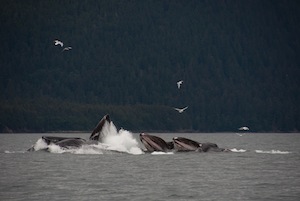 It would be gross touristic negligence to visit Juneau without going on a whale-watching excursion. To see these behemoth 45-foot-long denizens of the deep erupt 15 feet or more from the water in a feeding frenzy is more than spectacular. It is, simply put, a sight that must be seen to be believed. Captain Greg of Weather Permitting Alaska takes us out in his aluminum boat to show us these enormous creatures, telling me that he guarantees a whale sighting.
It would be gross touristic negligence to visit Juneau without going on a whale-watching excursion. To see these behemoth 45-foot-long denizens of the deep erupt 15 feet or more from the water in a feeding frenzy is more than spectacular. It is, simply put, a sight that must be seen to be believed. Captain Greg of Weather Permitting Alaska takes us out in his aluminum boat to show us these enormous creatures, telling me that he guarantees a whale sighting.
He lives up to his word. Twenty minutes later we are watching a sight that would excite even the most jaded tourist or wildlife photographer — humpback whales bubblefeeding. One of the whales makes a primal grunting sound somewhat akin to a distorted foghorn and dives below a school of unsuspecting herring. The whale then blows bubbles that rise, scaring the herring into a tight ball. Meanwhile, nine other whales have dived deep under the water, forming into a circle. They rise rapidly up to the surface, their enormous jaws wide open, scooping hundreds of pounds of herring and plankton into their gaping maws.
Exactly eleven seconds after the foghorn warning the whales, like prehistoric monsters, breach simultaneously from the water in a gigantic waterspout and then slam down onto the water on their backs and sides, to disappear with a blast of steam from their blowholes and a last flick of their mighty trident-shaped tails. It’s quite a performance and I can hardly speak for a while afterwards, apart from a lame, “Did you see that?” We follow the whales for an hour or so, see this performance repeated a c
ouple of times, and return to shore very happy campers.
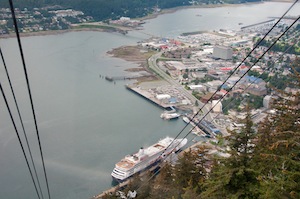 Back in Juneau, we take the Mount Roberts Tramway to the top of the steep, 2,000-foot-high mountain of the same name, and catch a breathtaking view of Gastineau Channel and Douglas Island far below us. This panorama of absolute seclusion is a powerful reminder of how Juneau can only be reached by boat or plane — there are no roads leading into Juneau from the mainland. We visit a half-blind eagle in a shelter, walk along the hiking trail for a while, and watch an informative movie, Seeing Daylight, about Tlingit Indian legends, culture, and language.
Back in Juneau, we take the Mount Roberts Tramway to the top of the steep, 2,000-foot-high mountain of the same name, and catch a breathtaking view of Gastineau Channel and Douglas Island far below us. This panorama of absolute seclusion is a powerful reminder of how Juneau can only be reached by boat or plane — there are no roads leading into Juneau from the mainland. We visit a half-blind eagle in a shelter, walk along the hiking trail for a while, and watch an informative movie, Seeing Daylight, about Tlingit Indian legends, culture, and language.
Back down the mountain we walk along Juneau’s tidy streets exploring its touristy shops, galleries, museums, and restaurants. The historic district of town, with its turn-of-the-century western facades, is an eclectic milieu of jewelry and souvenir shops that feeds the insatiable thirst of the cruise ship passengers, interspersed with bars of all stripes, and hardware and convenience stores for the residents. Pretty planter boxes of colorful flowers, twin-globe street lamps, and festive banners brighten up the sidewalk as a trolley car clangs its way along the street.
Watching the enormous cruise ships berthing and sightseeing seaplanes buzzing to and fro across the harbor reinforces just how much tourism is the lifeblood of this city.
Don’t miss the iconic Red Dog Saloon, but time your visit after the cruise passengers have retreated, or you’ll have to wait a while. This touristy recreation of a noisy honky-tonk bar seems to have captured the spirit of the 1890’s during the town’s gold rush heyday, complete with sawdust floor. Look for Wyatt Earp’s gun, some Winchester rifles, a mounted Kodiak bear, and other frontier paraphernalia displayed behind the bar.
For beer aficionados, the Alaskan Brewing Company makes for a lively stop. In 1986, when the Alaskan Brewing Company set up its brewery in Juneau, it became the 67th operating brewery in the United States. Since then, its products have been awarded more than 100 major national and international medals and awards, half of which are gold. Its most renowned brews, Alaskan Amber, Alaskan IPA, Alaskan Stout, Alaskan Summer Ale, and Alaskan Winter Ale, are uniformly thirst-quenching. Drop by and sample up to six of their delicious beers, free of charge. You’ll meet a fun mix of locals and tourists, all with a passion for beer.
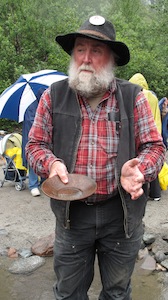 Much of Juneau’s history revolves around its gold mining days that started in 1880, so you’ll find plenty of gold mining museums and tours here. Tucked away in a rugged mountain valley behind Juneau, the Last Chance Mining Museum is absolutely crammed, floor to ceiling, with thousands of old pieces of gold mining equipment ranging from small to enormous. The gadgets make the museum look like the setting for a Steampunk Convention.
Much of Juneau’s history revolves around its gold mining days that started in 1880, so you’ll find plenty of gold mining museums and tours here. Tucked away in a rugged mountain valley behind Juneau, the Last Chance Mining Museum is absolutely crammed, floor to ceiling, with thousands of old pieces of gold mining equipment ranging from small to enormous. The gadgets make the museum look like the setting for a Steampunk Convention.
In one corner of the museum stands a replica of the AJ Mine Adit, the mine entrance. The original mine entrances are sealed off to the public, so this replica was created to give the visitor an idea of what a mine was like back in the day. Walking through, you’ll see historic photographs, a wide display of hand tools that were used in the shops for maintaining the mining equipment, pneumatic drilling equipment, and ancient picks and rock samples.
The remnants of another gold mine are seen on the AJ Mine and Gastineau Mill Tour — and they’ll show you how to pan for gold. The tour bus ascends a steep trail up Mount Roberts to what remains of the Alaska Gastineau Mill. A guide shows large black and white photos outlining the different types of gold mining, demonstrates how to operate a sluice box, and then describes hydraulic mining, dredging, open pit mining, and underground hard rock mining.
Next you drive two minutes down the dirt trail and stop at the enormous rusting steel girders and concrete skeleton of the former mill, built into the steep mountainside. It was here that the ore carts opened to pour their contents into a rotating pebble mill, where the rocks were crushed into a sand-like product which was then sifted and washed to collect the gold.
Finally you’re whisked further down the hill for a tour inside the historic Gastineau Mine conveyor tunnel shaft, one of the highlights of the day. It’s the only hard rock gold mining tour in S.E. Alaska. Your guide escorts you into the cool, 360-foot-long mineshaft. Inside the mineshaft, 20 feet wide and 10 feet high, our voices and the gravel crunching underfoot echo down its length. The guide stops to demonstrate how work was done in the mines, sawing a joist, operating a bone-rattling pneumatic drill, and dumping ore into a hopper ore cart.
The Juneau-Douglas City Museum gives a concise and thorough history of the town. As one might expect, its major focus is on its mining history, with plenty of old photographs, interactive exhibits, dioramas, and displays about Hands-On Mining, to show the pioneer life as it was back in the mining days.
You can read stories about the mines from sliding panels, and a large, colorful display shows the types of rock at the Treadwell Mine. Glass cases contain typical clothing worn by miners, and some of their equipment.
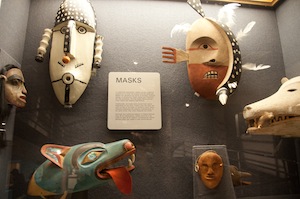 The Alaska State Museum, a white concrete building with art nouveau decorations sculpted into its walls, is only a ten-minute walk from the Juneau-Douglas City Museum, and is equally impressive. Although not as focused on mining as the Juneau-Douglas City Museum, it gives a polished, in-depth recounting of the state’s history and natural history, including Native Cultures, History Galleries, a For Kids Only section, and much more.
The Alaska State Museum, a white concrete building with art nouveau decorations sculpted into its walls, is only a ten-minute walk from the Juneau-Douglas City Museum, and is equally impressive. Although not as focused on mining as the Juneau-Douglas City Museum, it gives a polished, in-depth recounting of the state’s history and natural history, including Native Cultures, History Galleries, a For Kids Only section, and much more.
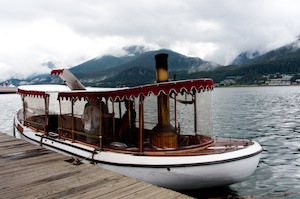 The Juneau Steamboat Company Harbor Tour, ably led by Captain John L. George, is a low-key summary of the Juneau gold rush heritage. You sit inside a turn-of-the-century, wood-fired passenger steamboat as it chugs sedately along the Gastineau Channel at 3.5 knots. Wearing a black vest complete with silver watch chain and captain’s hat, Captain George regales you with tales of how these steamboats were a common form of transport back in the day, ferrying miners and their families across the channel.
The Juneau Steamboat Company Harbor Tour, ably led by Captain John L. George, is a low-key summary of the Juneau gold rush heritage. You sit inside a turn-of-the-century, wood-fired passenger steamboat as it chugs sedately along the Gastineau Channel at 3.5 knots. Wearing a black vest complete with silver watch chain and captain’s hat, Captain George regales you with tales of how these steamboats were a common form of transport back in the day, ferrying miners and their families across the channel.
Where to stay:
For the complete experience, stay at the historic Silverbow Inn, a beautiful 1914 boutique hotel with 11 rooms decorated with antiques and period wallpaper. Situated in the heart of downtown Juneau, its old furnishings and creaking floors help you relive the good old days of mining in Juneau. The bakery next door is not to be missed.
If you’d like to purchase this article for your publication, click here to contact the author directly.
Can you get generic medications online legally. Part 2
